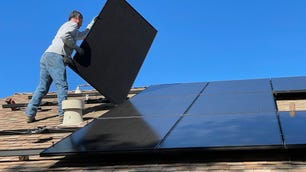There are many benefits of solar panels that homeowners know about — they lower your energy bill, reduce your carbon footprint and can even earn you a healthy tax credit.
But did you know going solar also increases the value of your home?
A 2019 report from Zillow indicated that properties with rooftop solar installations sold for 4.1% more than comparable residences without them. For a median-valued home, that’s equal to roughly $9,300.
And residences with solar are 24.7% more likely to sell for more than their asking price, according to property listings site Rocket Homes.
Tony Accardo, a Compass realtor in Los Angeles County, says solar is a “huge selling point” in his conversations with prospective buyers.
“If there were two identical homes, but one didn’t have solar and was $50,000 cheaper, the one with solar would sell first,” Accardo told CNET.
Here’s what you need to know about how and why solar panels can increase your home’s value.
How much solar panels increase your home’s value
There are tax breaks available when you buy and install a rooftop solar system, most notably the federal solar tax credit.
When it’s time to sell, though, how much of a premium having a rooftop solar system brings depends on a variety of factors — including where you live, the cost of electricity and what kind of system you have.
What’s most attractive to homebuyers is how much of your home’s energy needs your installation covers. If it can provide all of it, that can reduce your electricity bill by an average of $1,500 a year — equal to about $37,500 over the life of the system.
Read more: How Long Does It Take for Solar Panels to Pay For Themselves?
“If solar panels aren’t on buyers’ want list, it’s something they plan to install themselves,” Accardo said. “They want to offset energy costs and have a better resale situation themselves.”
Solar is even more of a “get” than having a pool, he added.
“An older couple looking at your house maybe isn’t going to care you have a pool. Or even see it as a pain,” Accardo said. “This is direct savings that everyone can take advantage of.”
Where you live matters
The value of a solar setup varies substantially by market. Unsurprisingly, buyers in states where electricity bills are higher place more of a premium on solar panels.
In January 2023, residential electricity bills were highest in California, Illinois, Michigan, New York, New Jersey, Pennsylvania, Wisconsin and across New England, according to the Energy Information Administration.
With the solar capacity to power over 13.9 million homes, California overwhelmingly has the largest residential solar market.
Below are the top 10 states for solar, based on data from the Solar Energy Industry Association on the cumulative amount of solar energy capacity installed through 2023 and the number of homes that could be powered by that energy.
States with the top solar markets in 2023
| Rank | State | MW of solar installed (cumulatively) | Number of homes that could be powered (rooftop and utility capacity) |
|---|---|---|---|
| 1 | California | 46,874 | 13,904,267 |
| 2 | Texas | 22,872 | 2,677,486 |
| 3 | Florida | 13,912 | 1,663,089 |
| 4 | North Carolina | 9,310 | 1,169,056 |
| 5 | Arizona | 7,675 | 1,173,331 |
| 6 | Nevada | 6,382 | 1,150,989 |
| 7 | Georgia | 5,913 | 710,506 |
| 8 | New York | 5,560 | 980,034 |
| 9 | New Jersey | 5,276 | 904,948 |
| 10 | Massachusetts | 5,070 | 912,036 |
Many of these states offer credits to homeowners who give excess energy back to the grid. And at least 36 states offer property tax exemptions for a home solar system. So while it will increase the value of your home, it won’t increase your tax bill.
A 2015 analysis by the Department of Energy’s Lawrence Berkeley National Laboratory found that buyers in California, Connecticut, Massachusetts, Minnesota, North Carolina and New Jersey paid $15,000 more for a home with a typical 3.6-kilowatt solar photovoltaic system. (The equivalent to about $4 more per watt generated.)
Specific metro areas have also risen to the top when it comes to adopting solar panels: Last year, they were most in demand in Los Angeles, San Diego, Honolulu, Phoenix, San Jose, San Antonio and New York City, according to a survey by the Environment California Research & Policy Center.
In New York, having solar panels upped the closing price of a property by 5.4%, compared to the 4.1% increase nationwide, Zillow reported. For a median-priced home in the Big Apple, that worked out to about an additional $24,000.

Watch this: How See-Through Solar Panels Could Bring Renewable Energy to Your Windows
Electricity prices will remain high
Though inflation rates were elevated at the beginning of the year, the Fed projects that it will still hit 2% by the end of the year. Even still, Mark Wolfe, director of the National Energy Assistance Directors Association, told USA Today that electricity prices may increase by as much as 10% in 2024.
That’s because liquified natural gas, which fuels over a third of Americans’ electricity, has become scarcer as the US exports a record amount to Europe, which has been struggling to replace the supply it no longer gets from Russia after its 2022 invasion of Ukraine.
“Unprecedented export volumes are, for the first time in history, binding American household energy bills to global calamities,” Wolfe wrote in an open letter last fall to Energy Secretary Jennifer Granholm.
He described the situation as “a domestic energy pricing crisis.”
Read more: Here’s How Solar Panels Can Save Homeowners Money
Asked about the reasons for adding solar panels, almost all (92%) homeowners who have installed them or considered doing so pointed to saving on utility bills, the Pew Research Center reported.
“People aren’t altruistic,” Accardo said. “They’re interested in solar because of saving, not because of the environment.”
Will solar always add value to my property?
Having a well-maintained rooftop solar system is highly unlikely to ever lower your property’s value, Accardo said. Even if you don’t have solar panels, buyers may pay more for a house with roofing that’s well-suited to installing them later.
But changes in state regulations can make solar less of a selling point: California recently altered its solar incentive from a net-metering system, where homeowners get a near-dollar-to-dollar credit for excess energy, to a net-billing program where your surplus is sold to the utility at a substantially lower rate.
Systems installed after April 14, 2023, could earn homeowners 75% less if they don’t also have a home battery setup, according to the California Solar and Storage Association, the state’s largest solar trade organization. (Existing systems are grandfathered under the current net-metering structure.)
Similar policy changes decreased the uptake of solar in Hawaii, Nevada and Missouri, the nonprofit Environment America reported.
In Arizona, new fees and regulations nearly doubled how long it takes solar panels to pay for themselves, leading to a decline in adoption of between 50% and 95%, EA reported. (Despite it being the sunniest state in the union, fewer than 200,000 homes in Arizona are powered by solar.)
The state of your panels and your home are also a factor. If a buyer sees that they’re going to have to invest in repairs, it will likely drive the price down.
And as other states adopt net billing, having solar panels paired with a home battery backup system will be increasingly important to get the most value for your home.
For more on solar panels, find out how to avoid scams and learn about the big changes to California’s solar incentives.



